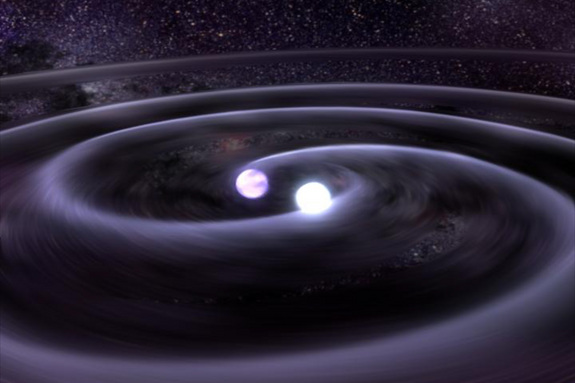Gravitational waves are the “smoking gun” of the Big Bang.
Predicted by Albert Einstein’s theory of general relativity in 1916, a massive object like Earth distorts space-time around it like a bowling ball dropped on a trampoline. The larger the object, the more space-time is distorted by it. If a marble were circling around the bowling ball on the dimpled trampoline, it would fall inward, toward the bowling ball, like a rock in space circling a planet. Gravitational waves are ripples in space-time that travel outward from a source. [VIDEO: Gravitational Waves Simply Explained With a Cube and a Marble ]

This illustration shows the gravitational waves thought to be produced by two orbiting white dwarf stars in a binary system called J0651, according to an August 2012 study.
Credit: NASA
Scientists think that powerful gravitational waves are created when two extremely dense objects — like a pair of neutron stars or a black hole and a neutron star — orbit one another in binary pairs. The interaction of those two objects swirl space-time, creating ripples that theoretically can be measured using powerful instrumentation. [See images of gravitational waves ]
Background noise
In 2014, the Harvard-Smithsonian Center for Astrophysics found a faint signal in the cosmic microwave background radiation (CMB). They announced that the signal signified the first direct evidence of gravitational waves ever discovered. Gravitational waves were the last untested part of Einstein’s general theory of relativity. Unfortunately, the signal detected by their research could be explained by dust in the Milky Way .
However, the announcement highlighted one method for spotting gravitational waves. The rapid expansion of the universe (called inflation) right after the Big Bang nearly 13.8 billion years ago could have produced ripples in the CMB — the cosmic fog that fills the universe and represents the earliest detectable radiation. If spotted in the future , such ripples would further support the idea that the universe went through a huge period of inflation a fraction of a second after the Big Bang.
[Video: Historic Gravitational Waves Discovery Explained By Experts ]
Cosmic inflation
CMB radiation came into existence about 380,000 years after the Big Bang. Scientists have mapped the CMB across the sky and found that it is a uniform temperature, evidence that bolsters cosmic inflation theory.
“Why the cosmic microwave background temperature is the same at different spots in the sky would be a mystery if it was not for inflation saying, well, our whole sky came from this tiny region,” Chuck Bennett, principal investigator of NASA’s Wilkinson Microwave Anisotropy Probe (WMAP) mission, told Space.com in 2013. “So the idea of inflation helps answer some of these mysteries, and it explains where these fluctuations came from.”
Smoking gun
In 2016, the Advanced LIGO (Laser Interferometer Gravitational Wave Observatory) announced its first (and then its second) clear detection of gravitational waves. The discovery was met with excitement by both the general public and the scientific community .
The first announcement , made in February 2016, revealed the historic confirmed detection made in September 2015. A pair of black holes, weighing in at 29 and 36 times the mass of the sun, merged into a single object, producing the ripples in space-time that LIGO detected. The September signal was the first detection of binary black holes.
The LIGO team announced a second gravitational wave signal, which the pair of instruments detected on December 26, 2015. Like the first, the signal is thought to have come from a pair of colliding black holes.
The crashing twin pairs are far from the largest black holes. The supermassive black hole at the center of the Milky Way weighs in at over 4 million times the mass of the sun. The intermediate mass black holes are more challenging to explain than their larger siblings.
“The 29 and 30-plus solar masses come as an unusual surprise. If you look at most binary stars in [the Milky Way] galaxy, given the composition of the stars, we don’t expect black holes of this mass,” black hole scientist and LIGO team member Vicky Kalogera told Space.com soon after the first discovery.
“The higher mass tells us that these binary black holes formed from a particular environment [with a] metallicity that is different than [the sun’s] metallicity.”
As LIGO continues to study space-time, and as more detectors come online (such as one proposed by India ), scientists will improve their understanding of intermediate black holes and black hole pairs .
“For every combination of masses and spins of black holes, you get a different [signal],” LIGO spokesperson Gabriela Gonzalez said during the 228th American Astronomical Society meeting in San Diego, California in June 2016.
In 2012, California Institute of Technology emeritus professor of physics Kip Thorne, a leading proponent of LIGO, predicted that the instrument would reveal a bounty of gravitational waves .
“We expect to see black holes colliding at a rate of perhaps somewhere between once an hour and once a year,” Thorne said.
Gravitational waves are different from gravity waves , which are ripples created in the atmospheres of planets by the interactions of winds whipping over geological features on the planet’s surface.
Additional reporting by Nola Taylor Redd, Space.com contributor.
Comments are closed.